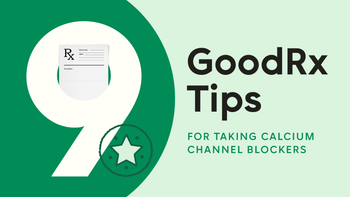
6 Amlodipine Interactions You Should Know About
Key takeaways:
Amlodipine (Norvasc) is a medication that’s taken for high blood pressure and chest pain. While it’s commonly used, it can interact with several medications. Examples include simvastatin (Zocor), transplant medications, and certain antifungal medications.
Some amlodipine interactions can result in an increased risk of side effects. Others can affect how well certain medications are working for you.
Share your current medication list with your healthcare provider and pharmacist. They can screen for potential interactions and help you manage them ahead of time.
Access savings on related medications

For many people, amlodipine (Norvasc) is a first-choice option to manage their blood pressure. And it’s used to relieve chest pain, too. While it’s one of the most commonly prescribed medications in the U.S., it may interact with other medications you’re taking.
Most amlodipine interactions have to do with how it interacts with specific proteins in your body. In some cases, these interactions can make amlodipine side effects more likely. With others, amlodipine may cause higher levels of other medications in your body. Luckily, many of these interactions can be managed. Let’s review a few you should know about and how to manage them.
1. Simvastatin
Simvastatin (Zocor) is a statin medication that’s used to treat high cholesterol. It can also help lower the risk of heart attack and stroke in certain people. Unlike most other statins, simvastatin is known to interact with amlodipine.
Save over 40% on Qsymia with GoodRx
Discover the once daily Qsymia for weight management. Qsymia is for adults and children 12-17 in combination with a healthy diet and regular exercise.

When taken together, amlodipine can increase simvastatin levels in your blood. A similar interaction may also be possible with lovastatin. This can lead to a higher risk of statin-related side effects, like muscle damage. The FDA recommends limiting your simvastatin dosage to 20 mg daily to lower this risk.
Your healthcare provider may decide to lower your simvastatin dosage or have you take a different statin if you need to take amlodipine.
2. Transplant medications
Cyclosporine (Sandimmune) is an immunosuppressant medication used to prevent organ transplant rejection. Cyclosporine modified (Neoral, Gengraf) is another form of this medication. It’s used for organ transplants as well as to treat autoimmune conditions, like rheumatoid arthritis and psoriasis.
Amlodipine can increase the amount of cyclosporine in your blood. This can put you at risk for liver problems or kidney damage.
Tacrolimus (Prograf) is another medication used to prevent organ transplant rejection. Similar to cyclosporine, amlodipine can increase tacrolimus levels in your blood. This can lead to side effects like nausea, diarrhea, or constipation. In some cases, higher tacrolimus levels can contribute to heart problems or kidney damage.
Your transplant care team will regularly monitor your medication levels during treatment. If needed, they’ll adjust your dosage to ensure it’s safe and effective for you. They will also ensure other medications you’re taking are compatible with your transplant regimen.
3. Rifampin
Rifampin is a medication used to treat tuberculosis and prevent meningococcal disease transmission. It’s known to interact with many medications. That’s because it affects certain liver proteins and how they break down medications in your body.
When taken together, rifampin can increase the breakdown of amlodipine in your liver. This can result in lower levels of amlodipine. So, your current dosage may not work as well for you. To manage this interaction, your healthcare provider may need to adjust your amlodipine dosage.
4. Sildenafil
Sildenafil (Viagra) is commonly used to treat erectile dysfunction. It works by relaxing blood vessels to improve blood flow to the penis for an erection. Sildenafil is also available as Revatio to treat pulmonary hypertension. In this case, it helps improve blood flow to the lungs. However, these effects can also cause your blood pressure to decrease.
Amlodipine also lowers your blood pressure by relaxing your blood vessels. When it’s combined with sildenafil, your blood pressure could get too low. This is called hypotension.
If you’re taking amlodipine, speak with your healthcare provider before taking sildenafil. They can determine if this combination is safe for you to take.
Contact your healthcare provider if you have blurry vision, dizziness, or feel faint with this combination. Your medications may need to be adjusted to manage this interaction.
5. Certain antifungal medications
Certain antifungal medications can interact with amlodipine. Examples include itraconazole (Sporanox), ketoconazole, and voriconazole (Vfend). They’re used to treat fungal infections of the skin, blood, and sometimes, lungs.
These antifungals block certain liver proteins from breaking down amlodipine, leading to higher levels in your body. This can increase your risk of side effects, including swelling, flushing, and dizziness. Your blood pressure could also drop too low.
Your healthcare provider may need to adjust your amlodipine dosage while taking one of these antifungal medications. Let them know if you notice any new or worsening side effects during treatment.
6. Ritonavir
Ritonavir (Norvir) is a unique medication that’s mainly used to boost the effects of other antiviral medications. For example, some HIV medications and Paxlovid (nirmatrelvir/ritonavir) contain ritonavir to make them work better.
Like antifungal medications, ritonavir can increase amlodipine levels in your body. This can increase the likelihood of experiencing side effects.
Paxlovid is only taken for 5 days. So this combination may not require a dosage adjustment. But HIV medications containing ritonavir are usually taken long term. In this case, your healthcare provider may need to adjust your amlodipine dosage.
Let them know if you experience dizziness, lightheadedness, or swelling during treatment if you’re taking these medications together.
When should I contact my healthcare provider about an amlodipine interaction?
Your healthcare provider is likely already aware of any potential amlodipine interactions. But it never hurts to double check. Not all interactions are dangerous or need to be avoided. Many can be managed with dosage changes and/or monitoring.
Even so, contact your healthcare provider if you notice amlodipine side effects. This can include lightheadedness and swelling. And if you regularly monitor your blood pressure and it starts running higher than usual, this could be a sign that your amlodipine dosage needs to be increased.
Make sure your healthcare provider and pharmacist have your current medication list. This can help them check for potential interactions ahead of time.
The bottom line
Amlodipine can interact with several medications. Some amlodipine interactions can increase the risk of side effects. Others can prevent certain medications from working as well. In most cases, these interactions can be managed with safer alternatives, dosage changes, or monitoring.
Why trust our experts?



References
Bryant Ranch Prepack. (2022). Amlodipine besylate [package insert].
Bryant Ranch Prepack. (2022). Rifampin [package insert].
Mukherjee, D. (2016). AHA statement on drug-drug interactions with statins.
U.S. Food and Drug Administration. (2017). FDA drug safety communication: New restrictions, contraindications, and dose limitations for Zocor (simvastatin) to reduce the risk of muscle injury.
Whelton, P. K., et al. (2017). 2017 ACC/AHA/AAPA/ABC/ACPM/AGS/APhA/ASH/ASPC/NMA/PCNA Guideline for the prevention, detection, evaluation, and management of high blood pressure in adults: A report of the American College of Cardiology/American Heart Association Task Force on Clinical Practice Guidelines. Hypertension.
Was this page helpful?
Related Articles
Browse medications
View AllResearch prescriptions and over-the-counter medications from A to Z, compare drug prices, and start saving.




























